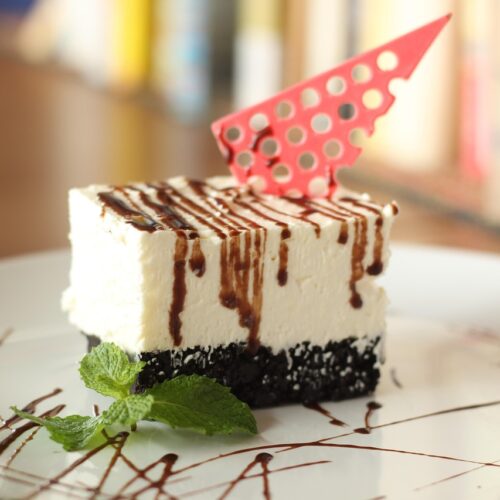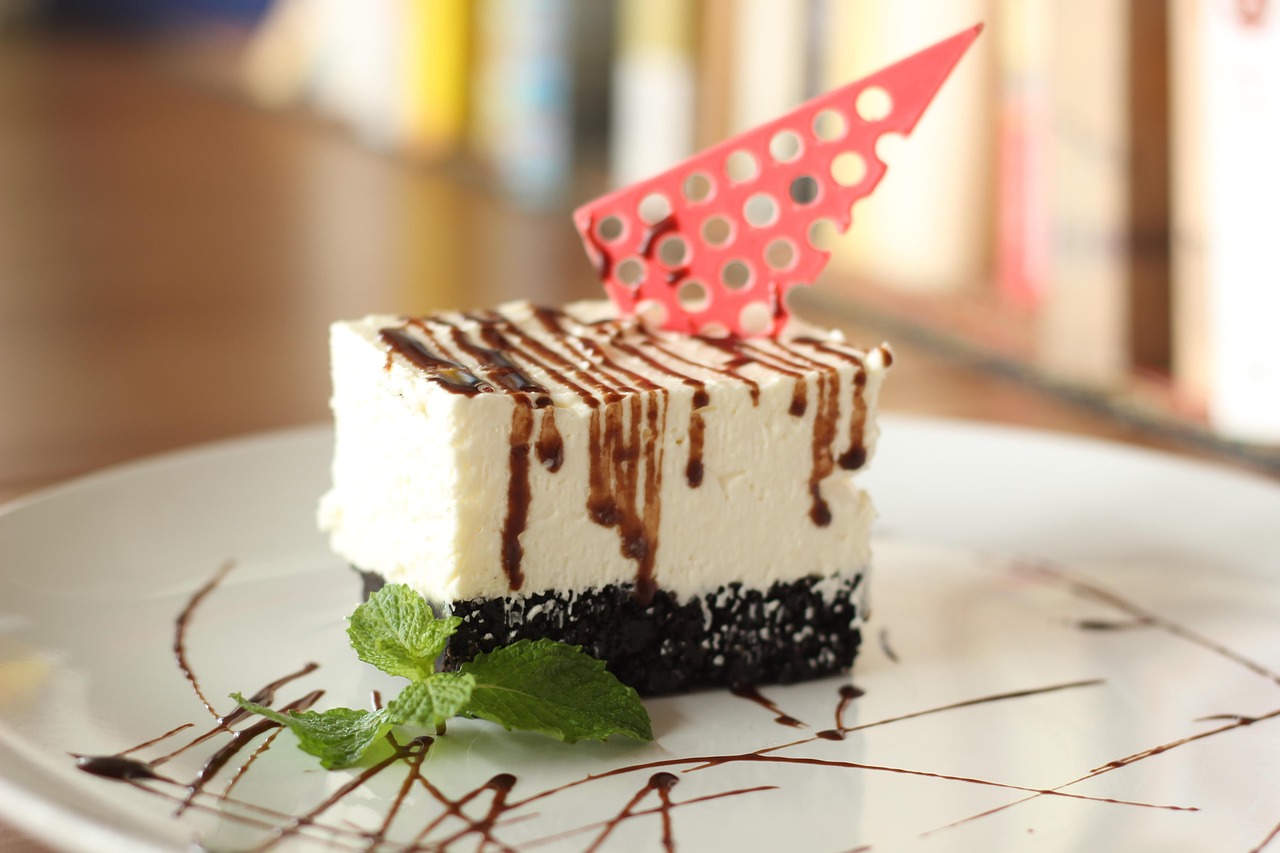Classic, creamy, and rich — this homemade cheesecake recipe features a buttery graham cracker crust and a smooth, tangy filling. Perfect for any occasion

Ratings 05

What Is The Cheesecake?
Cheesecake is a rich and creamy dessert made primarily from cream cheese, eggs, and sugar, typically set atop a crust made from crushed cookies or graham crackers mixed with butter.
There are two main types:
- Baked Cheesecake – Made by baking the cream cheese mixture until set, resulting in a dense and smooth texture.
- No-Bake Cheesecake – Set in the fridge using gelatin or whipped cream, offering a lighter, mousse-like texture.
01. Key Features Of Cheesecake
- Base: Usually a crumbly crust made from graham crackers, digestive biscuits, or cookies.
- Filling: Soft, smooth, and tangy filling made from cream cheese, sweeteners, and sometimes sour cream or heavy cream.
- Toppings (optional): Fruit compote, chocolate ganache, whipped cream, nuts, or fresh berries.
02. Common Cheesecake Flavors
- Classic New York-style
- Chocolate
- Strawberry or blueberry
- Lemon
- Matcha
- Pumpkin
- Mango
Health Benefits Of Cheesecake
While cheesecake is generally considered a rich and indulgent dessert, it can offer a few health benefits when eaten occasionally and in moderation:
01. Good Source Of Protein
Cream cheese and eggs provide high-quality protein, which supports muscle repair, hormone production, and immune function.
02. Contains Calcium
Dairy ingredients like cream cheese, sour cream, and heavy cream are rich in calcium, essential for strong bones and teeth.
03. Provides Healthy Fats
Though high in fat, cheesecake contains unsaturated fats (especially if made with ingredients like nuts or sour cream), which help support brain and heart health.
04. Rich In Vitamins
Eggs and dairy in cheesecake contribute:
- Vitamin A (for vision and immune health)
- Vitamin B12 (for the formation of red blood cells and nerve function)
- Riboflavin (B2) (for energy production)
05. Energy Boost
With its carbohydrates and fats, cheesecake can offer a quick source of energy, which may be helpful in small portions before physical or mental activities.
06. Note Of Caution
Cheesecake is best consumed in moderation due to its high calorie, sugar, and saturated fat content:
- In moderation
- As part of a balanced diet
- Or made with healthier alternatives (e.g., reduced sugar, Greek yogurt, whole grain crust)
Tips For Making Cheesecake
Whether you’re baking a classic New York-style or a fruity no-bake version, these tips will help you create a smooth, creamy, and crack-free cheesecake:
01. Use Room Temperature Ingredients
Cream cheese, eggs, sour cream, and heavy cream should all be at room temperature. This ensures a smoother batter and prevents lumps.
02. Don’t Overmix The Batter
Mix until just combined.If too much air is incorporated throughout mixing, the cheesecake may rise excessively and then crack as it cools.
03. Use A Water Bath (Bain-Marie)
Bake your cheesecake in a water bath for even heat and a moist baking environment. This helps prevent the top from cracking.
- Suggestion: To stop water from seeping in, cover the springform pan’s exterior with foil.
04. Tap The Pan Before Baking
Gently tap the filled pan on the counter to release any air bubbles in the batter.
05. Don’t Overbake
The center should still jiggle slightly when you gently shake the pan. It will set completely as it cools.
06. Cool Slowly
Let it cool gradually in the oven with the door cracked open for an hour, then bring to room temperature before chilling. Sudden temperature changes can cause cracks.
07. Chill Thoroughly
Chill for at least 4 hours, preferably overnight, to allow the cheesecake to fully set and develop flavor.
08. Use A Hot Knife For Slicing
Dip your knife in hot water and wipe it clean between slices for exact, clean cuts.
09. Add Toppings Just Before Serving
Fresh fruit, sauces, or whipped cream should be added at the end to keep the surface fresh and attractive.
10. Try Flavor Variations
Add citrus zest, chocolate, espresso, or fruit puree to the batter for creative flavors.
FAQ Cheesecake
Here are some frequently asked questions about cheesecake, with clear answers to help you get it just right:
01. Why Did My Cheesecake Crack?
Common reasons include:
- Overbaking
- Sudden temperature changes
- Overmixing the batter (adds air)
- Not using a water bath
Tip: Cool the cheesecake gradually and avoid opening the oven door during baking.
02. How Long Should I Chill My Cheesecake?
A: Chill for at least 4 hours, but overnight is best to allow it to fully set and develop flavor.
03. Can I Make Cheesecake In Advance?
A: Yes! Cheesecake actually tastes better the next day. You can make it 1–2 days ahead and store it in the fridge.
04. How Do I Cut Clean Cheesecake Slices?
A sharp knife dipped in hot water will be used for organizing and executing slices; clean the blade after each cut.
05. Can I Freeze Cheesecake?
Yes, cheesecake freezes well.
- Wrap tightly in plastic wrap and foil.
- Freeze for up to 2 months.
- Thaw overnight in the fridge before serving.
06. Can I Use Low-Fat Cream Cheese?
A: You can, but the texture will be less rich and creamy. For best results, use full-fat cream cheese or a mix of both.
07. How Do I know When My Cheesecake Is Done Baking?
A: The center should be slightly jiggly (like jelly), while the edges are set. will keep on getting stiffer as it cools.
08: What Are Some Popular Cheesecake Flavors?
- New York-style
- Chocolate
- Strawberry or blueberry
- Lemon
- Oreo
- Pumpkin
- Mango or passion fruit

Cheesecake
Ingredients
For The Crust
- 1 ½ cups (150g) graham cracker crumbs (or digestive biscuits, crushed)
- ¼ cup (50g) granulated sugar
- ½ cup (115g) unsalted butter, melted
For The Filling
- 4 packages (900g total) cream cheese, softened
- 1 cup (200g) granulated sugar
- 1 tsp vanilla extract
- 4 large eggs
- 2/3 cup (160ml) sour cream
- 2/3 cup (160ml) heavy cream
Optional Topping
- Fresh berries, fruit compote, or whipped cream
Instructions
- Preheat OvenPreheat your oven to 325°F (160°C).
Prepare The Crust
- In a mixing bowl, combine the graham cracker crumbs, sugar, and melted butter.
- Press the mixture firmly into the bottom of a 9-inch (23cm) springform pan.
- Bake for 10 minutes, then remove and let it cool while preparing the filling.
Make The Filling
- In a large bowl, beat the softened cream cheese until smooth and creamy.
- Add sugar and vanilla extract, and continue beating until well combined.
- Beat in eggs one at a time, mixing gently after each addition.
- Add sour cream and heavy cream, and mix until smooth.
Assemble And Bake
- Pour the filling over the cooled crust in the springform pan.
- Smooth the top with a spatula.
- Place the pan on a baking sheet and bake for 50–60 minutes, or until the center is just set and slightly jiggly.
Cool
- Turn off the oven, crack the door open slightly, and let the cheesecake cool inside for 1 hour.
- Remove and cool completely at room temperature.
Chill
- Cover and refrigerate for at least 4 hours or overnight before serving.
Serve
- Run a knife around the edge of the pan before releasing the springform.
- Add your favorite toppings and serve chilled.
-
Cheesecake
Classic, creamy, and rich — this homemade cheesecake recipe features a buttery graham cracker crust and a smooth, tangy filling. Perfect for any occasion Ratings 05 What Is The Cheesecake? Cheesecake is a rich and creamy dessert made primarily from cream cheese, eggs, and sugar, typically set atop a crust made from crushed cookies or…


Leave a Comment